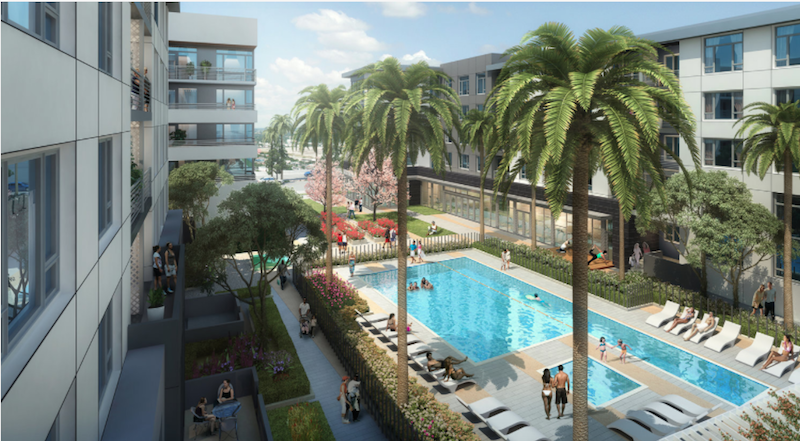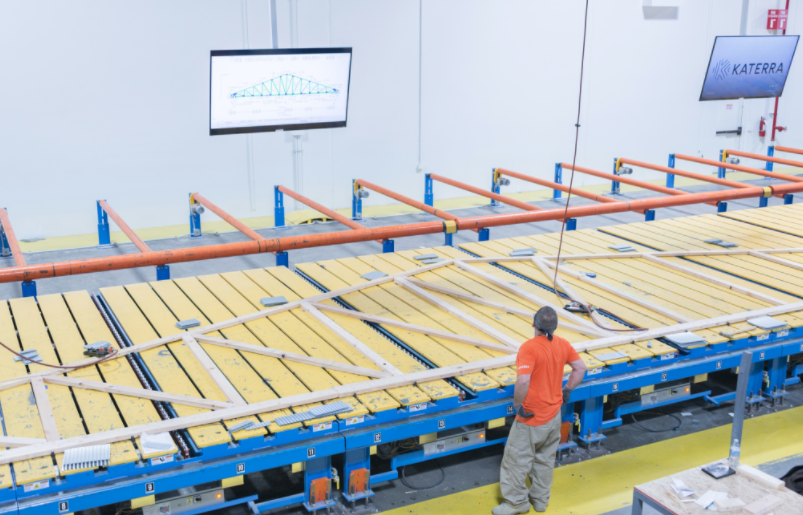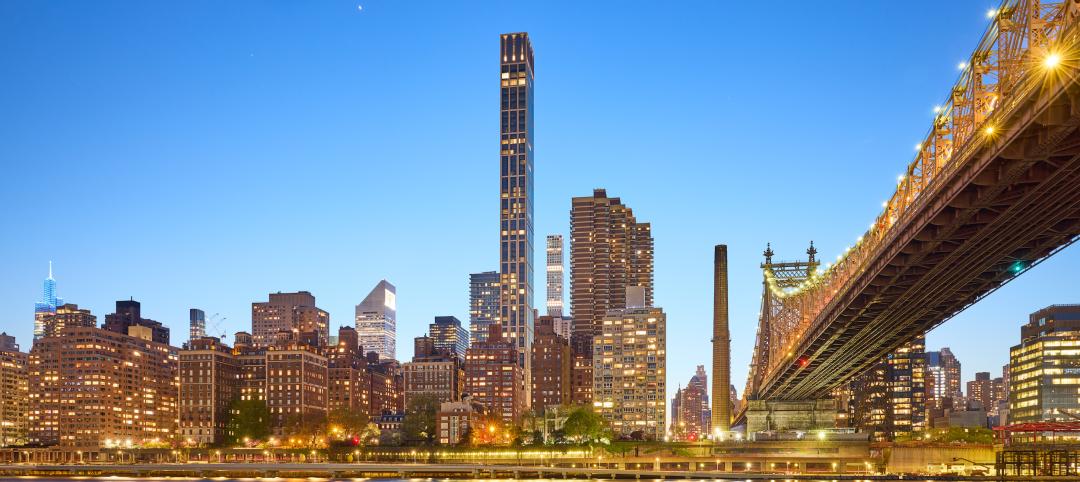By this time next year, Katerra—a technology startup whose end-to-end business model combines prefabrication, architectural, and construction services primarily for multifamily housing—expects to have six manufacturing plants up and running, including its first mass timber factory, a 250,000-sf building under construction on 29 acres in Spokane, Wash.
That plant, when fully operational in early 2019, will be capable of producing about 4.6 million cubic feet of cross-laminated timber annually. The plant’s size is comparable to CLT factories operating in Europe. “We’re going all in on CLT,” says Trevor Schick, who oversees Katerra’s supply chain, lighting, renovation, and commercial rollout activities.
Katerra’s initial success—it booked $1.3 billion in business last year—and its aggressive growth posture have attracted several high-profile investors, most prominently Japan’s SoftBank, from whose $100 billion Vision Fund Katerra recently raised $865 million in its latest round of financing.
SoftBank is steadily investing in tech-oriented companies that are impacting the built environment. In December, it paid $9.3 billion to acquire a 15% stake in Uber Technologies. It owns the robotics manufacturer and research firm Boston Dynamics. Last summer, SoftBank invested $200 million in the indoor farming enterprise Plenty. And it holds a $4.4 billion stake in WeWork, the cosharing office developer.
TechCrunch reported that the venture-capital world fully expects SoftBank to raise another $100 billion for future investments soon.
In-house design team and consortium
The Menlo Park, Calif.-based Katerra is already among the country’s largest GCs. The housing markets it serves include multifamily, senior and student living, and master-planned developments. Katerra’s largest customer is The Wolff Company, a real estate private equity firm that focuses on the multifamily sector, and whose executive chairman Fritz Wolff was one of Katerra’s Co-founders.
“Having a lead customer is important, given the investment we’re making in factories, IT, and so forth,” says Schick.
Katerra currently produces wall panels, roof and floor trusses, cabinets, and countertops from its factory in Phoenix, which began production in early 2017. That facility features Katerra’s Design Showroom, where clients can view a full suite of products and interior design solutions, including fully finished apartment units made entirely from Katerra-supplied products.
 Union Bay South in Carson, Calif., designed by Architects Orange, will offer 357 residential units, with four- and five-story wood framed buildings wrapping two separate concrete parking structures. The building, currently under construction, will include 30,000 sf of retail. Katerra is providing construction, management, and materials. Image: Katerra
Union Bay South in Carson, Calif., designed by Architects Orange, will offer 357 residential units, with four- and five-story wood framed buildings wrapping two separate concrete parking structures. The building, currently under construction, will include 30,000 sf of retail. Katerra is providing construction, management, and materials. Image: Katerra
Last June, Katerra acquired Nystrom Olson, a boutique architectural studio in Spokane. And six months later, it announced the forming of a design consortium whose members include Michael Green of Michael Green Architecture, a leader in mass timber architectural design; Andrea Leers of Boston-based Leers Weinzapfel Associates, which has also designed buildings using mass timber; Ted Flato of Lake|Flato in Texas; and Joe Greco of Lord Aeck Sargent, a full-service architecture and design firm with six offices.
With Green, Katerra is working on the design and construction of the new Hospitality Center in association with the Community Cancer Fund, Ronald McDonald House and Kootenai Health (Walden House) in Coeur d’Alene, Idaho.
Schick tells BD+C that, aside from the CLT plant in Washington, the other facilities Katerra moves into or builds this year will be conventional wood panel and truss factories. Its next mass timber plant is likely to be located in the Southeastern U.S., although Schick didn’t say when construction for that might start.
Leaning toward mass production
Katerra started as a materials supplier, with sourcing offices in Asia and Mexico. But the company soon realized that it needed a “larger scale” to get its cost model right, says Schick. That meant taking more control over the design, production, construction, and logistics of what it sold.
Technology has been the key to that transformation. Before joining Katerra, Schick spent over 15 years in the electronics industry, most recently as senior vice president at Hewlett-Packard involved in global supply chain and quality. One of Katerra’s Co-founders, Michael Marks, had been CEO of an electronics company now called Flex. A third Co-founder, Jim Davidson, founded Silver Lake, a technology investment firm.
Marks is convinced that building construction would benefit greatly from mass production techniques that are common in electronics and automotive manufacturing. Consequently, Katerra uses a kit-of-parts design system that it combines with prefabricated components production and onsite assembly.
The company’s technology platforms include SAP HANA, a market analytics platform that mines data from real estate and construction; a mobile app that connects its workforce in the field; and industrial IoT tools that optimize jobsite activity and track inventory.
 Katerra is building its first mass timber factory, a 250,000-sf building in Spokane, Wash., which will be able to produce 4.6 million cubic feet of product annually. Image: Katerra
Katerra is building its first mass timber factory, a 250,000-sf building in Spokane, Wash., which will be able to produce 4.6 million cubic feet of product annually. Image: Katerra
Schick says the company currently has 12 multifamily projects under way, ranging from 200 to 400 housing units per project. Sometime this year, he says the company plans to enter the hotel construction sector. Katerra also wants to build schools eventually.
As for projects using mass timber, Schick believes that demand among developers, contractors, and cities can only go up. He notes that the International Code Council has a vote scheduled for April to amend the 2021 International Building Code to allow for the use of CLT for buildings up to 18 stories. (Currently, CLT is limited in the U.S. to buildings no higher than six stories.)
In Washington State, ESB Bill 5450, which has passed both chambers of the legislature and is on the governor’s desk to sign, creates a section in the state statute defining qualifying mass timber products. It also directs the State Building Code Council to adopt rules for the use of mass timber in residential and commercial building, consistent with application national and international standards.
Katerra is already doing fire, earthquake, and wind sheer testing of CLT panels that it can make on its 60-foot-long by 12-foot-wide press.
Related Stories
Multifamily Housing | Jun 28, 2023
Sutton Tower, an 80-story multifamily development, completes construction in Manhattan’s Midtown East
In Manhattan’s Midtown East, the construction of Sutton Tower, an 80-story residential building, has been completed. Located in the Sutton Place neighborhood, the tower offers 120 for-sale residences, with the first move-ins scheduled for this summer. The project was designed by Thomas Juul-Hansen and developed by Gamma Real Estate and JVP Management. Lendlease, the general contractor, started construction in 2018.
Affordable Housing | Jun 27, 2023
Racial bias concerns prompt lawmakers to ask HUD to ban biometric surveillance, including facial recognition
Two members of the U.S. House of Representative have asked the Department of Housing and Urban Development to end the use of biometric technology, including facial recognition, for surveillance purposes in public housing.
Apartments | Jun 27, 2023
Average U.S. apartment rent reached all-time high in May, at $1,716
Multifamily rents continued to increase through the first half of 2023, despite challenges for the sector and continuing economic uncertainty. But job growth has remained robust and new households keep forming, creating apartment demand and ongoing rent growth. The average U.S. apartment rent reached an all-time high of $1,716 in May.
Apartments | Jun 27, 2023
Dallas high-rise multifamily tower is first in state to receive WELL Gold certification
HALL Arts Residences, 28-story luxury residential high-rise in the Dallas Arts District, recently became the first high-rise multifamily tower in Texas to receive WELL Gold Certification, a designation issued by the International WELL Building Institute. The HKS-designed condominium tower was designed with numerous wellness details.
Multifamily Housing | Jun 19, 2023
Adaptive reuse: 5 benefits of office-to-residential conversions
FitzGerald completed renovations on Millennium on LaSalle, a 14-story building in the heart of Chicago’s Loop. Originally built in 1902, the former office building now comprises 211 apartment units and marks LaSalle Street’s first complete office-to-residential conversion.
Urban Planning | Jun 15, 2023
Arizona limits housing projects in Phoenix area over groundwater supply concerns
Arizona will no longer grant certifications for new residential developments in Phoenix, it’s largest city, due to concerns over groundwater supply. The announcement indicates that the Phoenix area, currently the nation’s fastest-growing region in terms of population growth, will not be able to sustain its rapid growth because of limited freshwater resources.
Multifamily Housing | Jun 15, 2023
Alliance of Pittsburgh building owners slashes carbon emissions by 45%
The Pittsburgh 2030 District, an alliance of property owners in the Pittsburgh area, says that it has reduced carbon emissions by 44.8% below baseline. Begun in 2012 under the guidance of the Green Building Alliance (GBA), the Pittsburgh 2030 District encompasses more than 86 million sf of space within 556 buildings.
Industry Research | Jun 15, 2023
Exurbs and emerging suburbs having fastest population growth, says Cushman & Wakefield
Recently released county and metro-level population growth data by the U.S. Census Bureau shows that the fastest growing areas are found in exurbs and emerging suburbs.
Engineers | Jun 14, 2023
The high cost of low maintenance
Walter P Moore’s Javier Balma, PhD, PE, SE, and Webb Wright, PE, identify the primary causes of engineering failures, define proactive versus reactive maintenance, recognize the reasons for deferred maintenance, and identify the financial and safety risks related to deferred maintenance.
Mixed-Use | Jun 12, 2023
Goettsch Partners completes its largest China project to date: a mixed-used, five-tower complex
Chicago-based global architecture firm Goettsch Partners (GP) recently announced the completion of its largest project in China to date: the China Resources Qianhai Center, a mixed-use complex in the Qianhai district of Shenzhen. Developed by CR Land, the project includes five towers totaling almost 472,000 square meters (4.6 million sf).

















